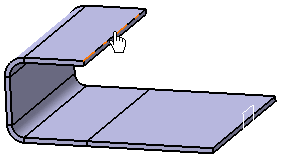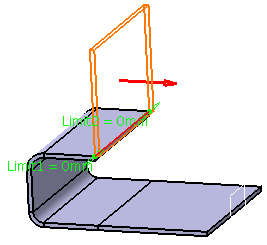Create a Basic Wall from Edges
You can create walls from edges.
Before you begin: Create a wall.
-
From the
Model section of the
action bar,
click
Wall on Edge
 and select an edge of the wall.
and select an edge of the wall.
The wall cannot intersect the selected edge.
-
Click
Automatic
 .
.
-
Specify the following options:
- The height type of the wall.
- The length of the wall.
-
Define the angle of the wall.
By default, it is perpendicular to the plane containing the edge. The angle is dynamically updated in the work area.
Tips: - You can use a predefined support by selecting an orientation plane. Right-click the Angle tag in the work area and select Orientation plane. Angle and clearance values become relative to the selected plane.
- You can define tangent walls (angle value = 180°).
- You can modify the support geometry by extrapolating it. This extrapolation is automatically computed.
- Optional: In the Bends frame, select With Bend.
- Optional:
Select the unfold method, and specify its parameters:
Option Description K-factor Defines the neutral fiber position inside the thickness, from the inner side of the bend. Bend Allowance The bend allowance corresponds to the unfolded bend width. Bend Deduction The bend deduction represents the sheet metal deformation when the bend is unfolded. Bend Table from Standards Uses the bend deduction table defined in the standards. You must select a standard containing a bend deduction table. Note: The Bend Table from Standards unfold method is automatically selected if a bend table is defined in the Sheet Metal parameters. If you do not want to use this unfold method, right-click the formula present on the radius feature, and remove it. Alternatively, you can choose another standard in the Sheet Metal parameters that does not contain a bend deduction table. For more information, see Editing the Sheet Metal Parameters. - Optional:
Select one of the following for each bend extremity:
Option Description Minimum with no relief The bend corresponds to the common area of the supporting walls along the bend axis, and shows no relief. Square relief The bend corresponds to the common area of the supporting walls along the bend axis, and a square relief is added to the bend extremity. The Length 1 and Length 2 parameters can be modified if needed. Round relief The bend corresponds to the common area of the supporting walls along the bend axis, and a round relief is added to the bend extremity. The Length 1 and Length 2 parameters can be modified if required. Linear The unfolded bend is split by two planes going through the corresponding limit points (obtained by projection of the bend axis onto the edges of the supporting walls). Tangent The edges of the bend are tangent to the edges of the supporting walls. Maximum The bend is calculated between the furthest opposite edges of the supporting walls. Closed The bend corresponds to the intersection between the bends of the two supporting walls. The closed bend extremity lies on the surface of the encountered bend. Flat joint The two bends are joined in flat view.





